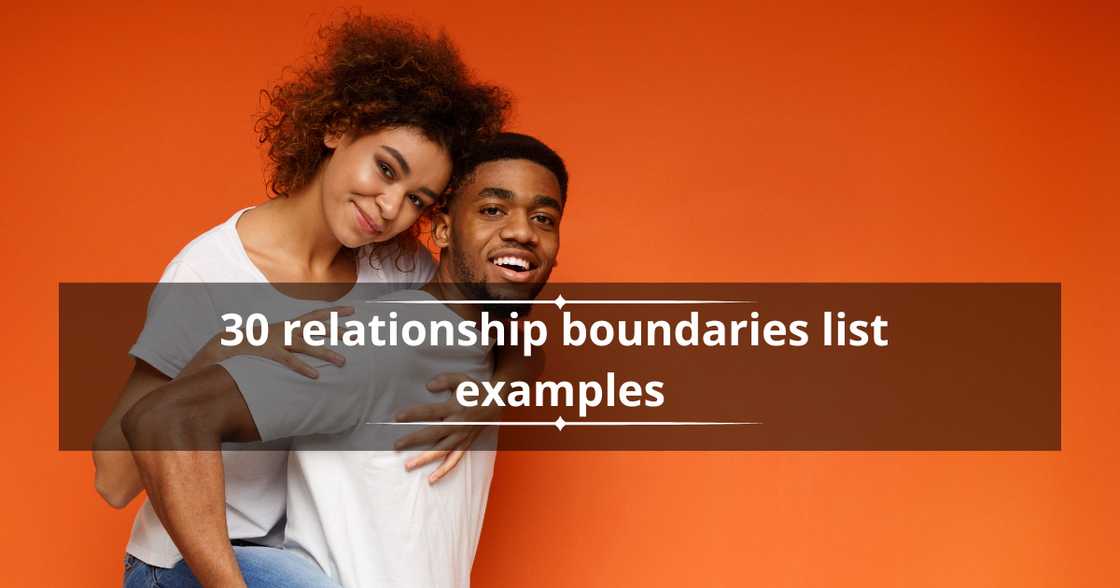30 relationship boundaries list examples: How to set healthy limits
Well-defined boundaries in relationships help them stand the test of time and thrive in challenges. They provide each individual involved with a sense of safety while assuring them of their value and need. What are some of the best relationship boundary list examples, and how do you set them in your relationship?

Source: Getty Images
TABLE OF CONTENTS
- Relationship boundaries list examples
- 1. Respecting emotional space
- 2. Defining intimacy and comfort
- 3. Managing finances in harmony
- 4. Personal possessions and relationship balance
- 5. Fostering open and respectful dialogue
- 6. Honouring personal space and consent
- 7. Balancing family dynamics and relationship needs
- 8. Navigating differences in parenting approaches
- 9. Prioritising quality time together
- 10. Resolving conflicts with compassion
- 11. Clarifying roles and responsibilities
- 12. Understanding and respecting boundaries on consent
- 13. Maintaining personal autonomy
- 14. Setting limits on social interactions
- 15. Supporting each other's well-being
- 16. Shared decision-making with mutual respect
- 17. Work-life balance
- 18. External influence
- 19. Managing privacy and interaction online
- 20. Ensuring digital security and trust
- 21. Preserving career growth within the relationship
- 22. Respecting each other's ideas and opinions
- 23. Self-improvement and growth
- 24. Past relationships and traumas
- 25. Household responsibilities
- 26. Respecting cultural differences in your relationship
- 27. Criticism and validation
- 28. Religion and politics
- 29. Social circle boundaries
- 30. Social gatherings and parties
- What is a boundary in a relationship?
- What types of boundaries are there in relationships?
- What are unacceptable boundaries in a relationship?
- How do you draw healthy boundaries in a relationship?
Healthy boundaries in relationships should not stop you from enjoying its joys. Instead, they should enhance the experience. This applies to relationships with self, lovers, acquaintances, family, and friends.
Relationship boundaries list examples
As an individual, knowing and enforcing your boundaries is the starting point of creating a healthy connection. Respecting boundaries is an expression of love. Here are some detailed relationship boundaries list examples for you to try.
1. Respecting emotional space
Emotional boundaries are set on the premise that each party's feelings are valid. They also acknowledge limits to taking responsibility for your partner's emotions.
They include taking responsibility for your emotions and staying true to your internal comfort level. Understand what is yours to fix in the relationship and what is not.
2. Defining intimacy and comfort
Intimacy is essential in romantic relationships. Openly discuss intimacy with your partner and speak up when your boundary is compromised.

Source: Getty Images
3. Managing finances in harmony
Setting up and honouring financial boundaries is vital in building trustworthiness in healthy relationships. Tips for making boundaries start with creating your personal budget and sticking to it. Genuinely consider your capabilities when making mutual financial commitments, such as dates.
4. Personal possessions and relationship balance
Material boundaries in relationships refer to limits placed around personal possessions and money. Limits on personal resources, possessions and money can add a layer of protection, allowing you to stay comfortably in a relationship.
Have open conversations about significant purchases such as expensive cars or homes. Agree on the ownership and usage of the assets.
5. Fostering open and respectful dialogue
Practice ways of ensuring communication lines remain open, such as using respectful and clear language and agreeing on an appropriate communication medium for different topics. Practise active listening.

Source: Getty Images
6. Honouring personal space and consent
Interpersonal space boundaries take on unique forms depending on upbringing, mental health, neurodiversity, and age. The foundation of this boundary is speaking up as soon as possible when your space is invaded. Seek consent before establishing body contact.
7. Balancing family dynamics and relationship needs
For couples, in-law interactions can potentially threaten the future of the relationship. With this in mind, it is also vital to recognise that the growth of your family unit requires input from in-laws and extended family. Making it necessary to balance the freedoms your families have.
8. Navigating differences in parenting approaches
To establish harmony, it is essential to remember that each of you was raised differently. Acknowledge and respect the differences in each other's parenting styles.
Discuss your expectations on parenting roles and define each other's responsibilities in the family. Have open conversations on future plans.
Agree to present yourselves as a unified front in parenting. Seek respectful solutions for handling conflict and disagreement, as this helps kids form balanced relationships.
9. Prioritising quality time together
Despite life's pressures, setting aside quality time is vital for a healthy relationship. This means allocating disruption-free and meaningful time for family. Be mindful to seek consent before disrupting each other's alone time.

Source: Getty Images
10. Resolving conflicts with compassion
Conflict can not be avoided. However, you can find healthy ways of handling it. Discuss ways of handling disagreement without personal attacks, yelling, insults or destructive behaviour. Seek solutions rather than placing blame during conflict resolution.
11. Clarifying roles and responsibilities
Defining your roles and responsibilities regarding finances, parenting, caregiving, and household chores in the relationship is paramount. Be open to conversations about each other's expectations.
12. Understanding and respecting boundaries on consent
In its simplest form, consent requires respect for each other's 'no'. This response can be verbal or non-verbal.
Remember to honour each other's privacy on information, possessions, social media and mobile devices. Seek consent before discussing distressing topics such as past relationships and trauma.
13. Maintaining personal autonomy
Personal autonomy refers to the ability to preserve and express one's individuality. To prevent toxic co-dependence, it is vital to set limits that allow one to retain their freedom.
These include allowing each other to participate in self-improvement efforts. In addition, respect each other's alone time without interrupting.

Source: Getty Images
14. Setting limits on social interactions
In romantic relationships, agree on boundaries in interactions with close friends and family. For acquaintances, define acceptable and unacceptable behaviour limits.
15. Supporting each other's well-being
Prioritise each other's needs for self-care and wellness. Offer each other assistance during seasons of emotional and mental stress. Support and encourage each other's exercise and dietary choices and health restrictions.
16. Shared decision-making with mutual respect
There should be clear limits on where shared and individual decision-making ends. Shared decision-making can involve finances, where to live, household duties, and parenting. Everyone should have an equal say in shared decisions, big or small.
17. Work-life balance
A work-life balance benefits those around you, helps reduce stress, and improves your health. This may include setting work-free time or spaces in the home. Constantly communicate schedules, work priorities, and respect for each other's work commitments.

Source: Getty Images
18. External influence
External influences can refer to work, study, culture, family, or finances and can apply undue stress to a couple's connection. This can be prevented by communicating your boundaries as a couple to your social circle. Keep communication lines clear and check in to manage changes in external influences.
19. Managing privacy and interaction online
Agreeing on privacy, shareable content, acceptable interactions, and social media unplugging is necessary in any relationship. These boundaries help guard the relationship from mistrust, jealousy, disconnection and misunderstandings.
20. Ensuring digital security and trust
Digital media privacy in relationships includes sharing passwords or devices and sensitive personal information. Creating and enforcing such boundaries is paramount in preventing cyberbullying or cyberstalking.
21. Preserving career growth within the relationship
Career-related aspects are closely connected with preserving personal autonomy in a relationship. Discuss your future career plans transparently without burdening the relationship. However, be open to compromise and flexibility.

Source: Getty Images
22. Respecting each other's ideas and opinions
Everyone has a right to voice their ideas, thoughts, interests or opinions. Manoeuvering this boundary is dependent on having mutual respect for each other. Listen to each other's ideas and perspectives without judgment or criticism.
23. Self-improvement and growth
Self-awareness helps you articulate your needs, weaknesses, and strengths, making it clear where to concentrate your energy for growth. Set frequent check-ins with your partner to discuss individual goals and dreams and adjust support.
24. Past relationships and traumas
Create a safe environment for each other to heal from past experiences. This can be done by asking questions and listening to each other. Communicating openly where continued interactions with past partners are necessary.
25. Household responsibilities
Household chores might seem like mundane parts of the home. However, they can quickly become a source of conflict. To maintain household harmony, clearly define and assign all chores in the home, considering availability and fairness.

Source: Getty Images
26. Respecting cultural differences in your relationship
Honesty and openness make it easy to decide the limits of cultural impact on the relationship. Acknowledge and respect each other's cultures, practices, and family traditions. Support your partner's cultural expression and identity without ridicule or judgment.
27. Criticism and validation
While emotional support is valuable, effectively processing your feelings is key to avoid overwhelming your partner. Communicate your criticism respectfully and constructively.
28. Religion and politics
It is important to acknowledge that you both can hold different views on politics and religion in relationships. Respect your opinion differences in political and religious views.
29. Social circle boundaries
It is vital to create a healthy balance between time spent with friends and your partner. Plan and communicate your social calendar in advance. Set boundaries on the influence of your social life on relational finances, possessions or decision-making.
30. Social gatherings and parties
Friendships are crucial, yet it's imperative to maintain privacy within them. Partners should be free to keep friendships without feeling pressured to share every detail with the other. Trust in each other's discretion when handling friendships is key to preserving loyalty to the relationship and individual privacy.
What is a boundary in a relationship?
These are invisible lines or rules that define the acceptability of behaviour. They can apply to physical, psychological, and emotional matters in the relationship.
What types of boundaries are there in relationships?
Although they are not included in wedding vows, partners in healthy relationships respect each other's physical, emotional, sexual, intellectual, and mental boundaries.
What are unacceptable boundaries in a relationship?
Unacceptable boundaries are limits or restrictions that aim to control, violate, or cause harm. They include invasive, restrictive, disrespectful, abusive, or unfair limits.
How do you draw healthy boundaries in a relationship?
Establishing healthy boundaries in a relationship requires clear communication, self-awareness, and mutual respect. The following are basic steps to set these boundaries:
- Use 'I' statements to communicate your boundaries.
- Use specific, clear, and assertive language.
- Create time for the discussion.
- Promptly address conflicts and enforce boundaries.
- Seek help from a professional.
These relationship boundaries list examples cover essential aspects such as time, communication, finances, religion, family, and property. Couples should embrace mutual respect, openness, and honesty to create healthy boundaries.
Legit.ng has published an article on deep questions you can ask your partner for a long, healthy relationship. The collection covers perfect questions to break the ice on first dates to marriage.
Genuine interest in your partner creates a strong sense of understanding and deepens your bond as a couple. Read the article for a curated selection of deep questions to ask your partner.
Source: Legit.ng











